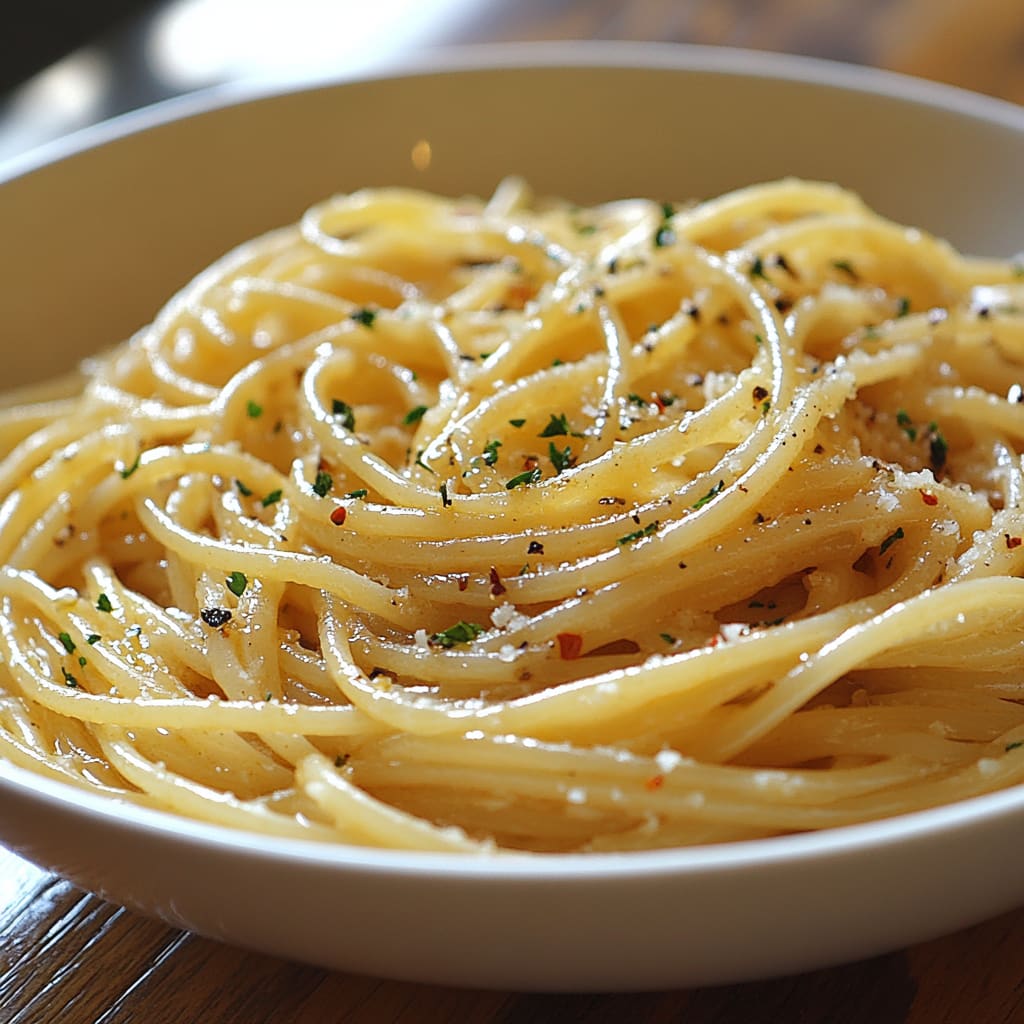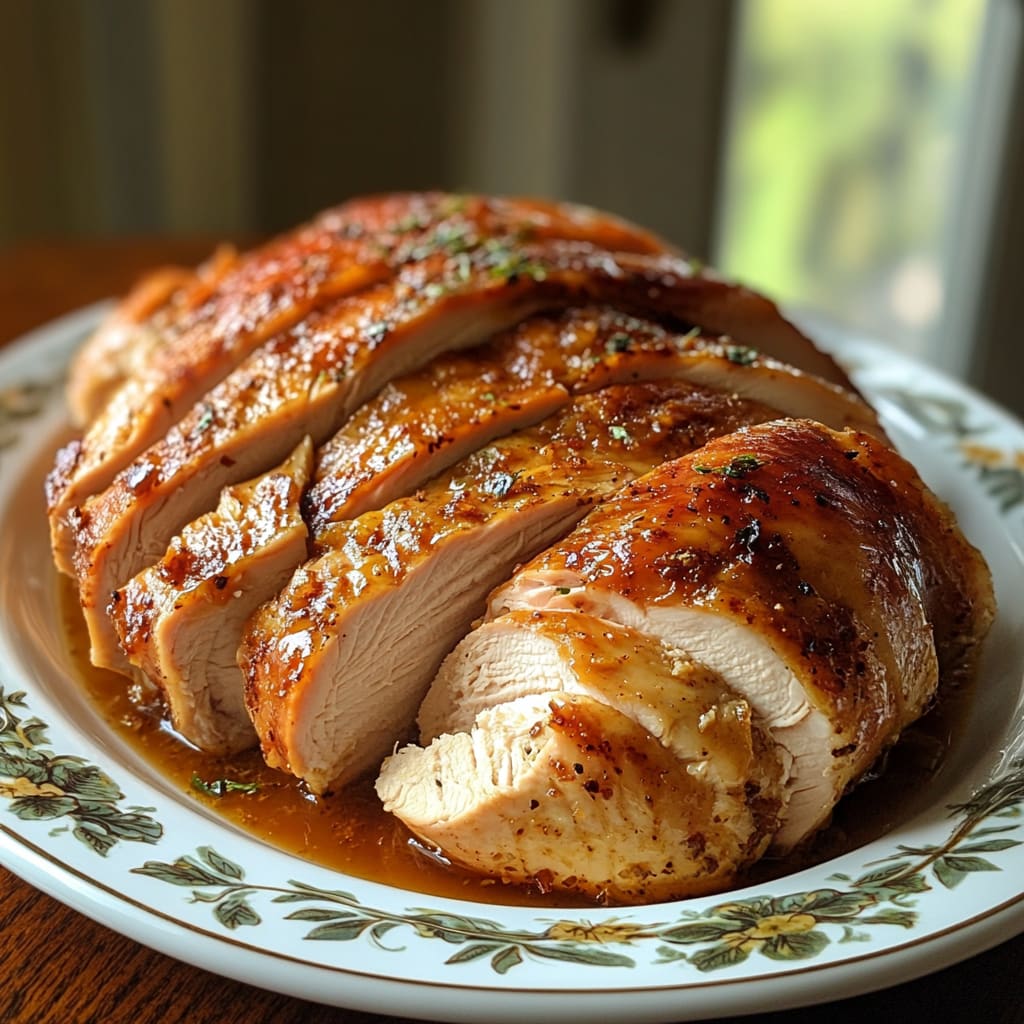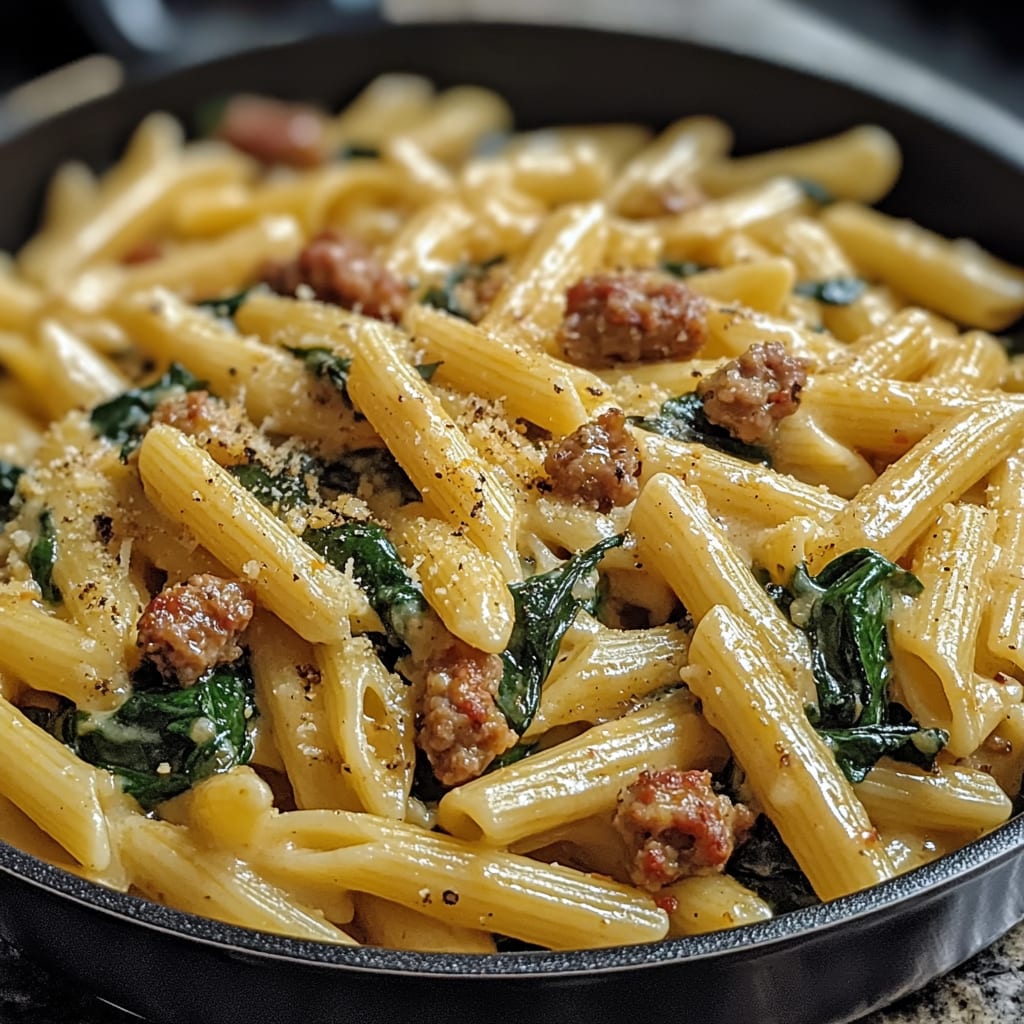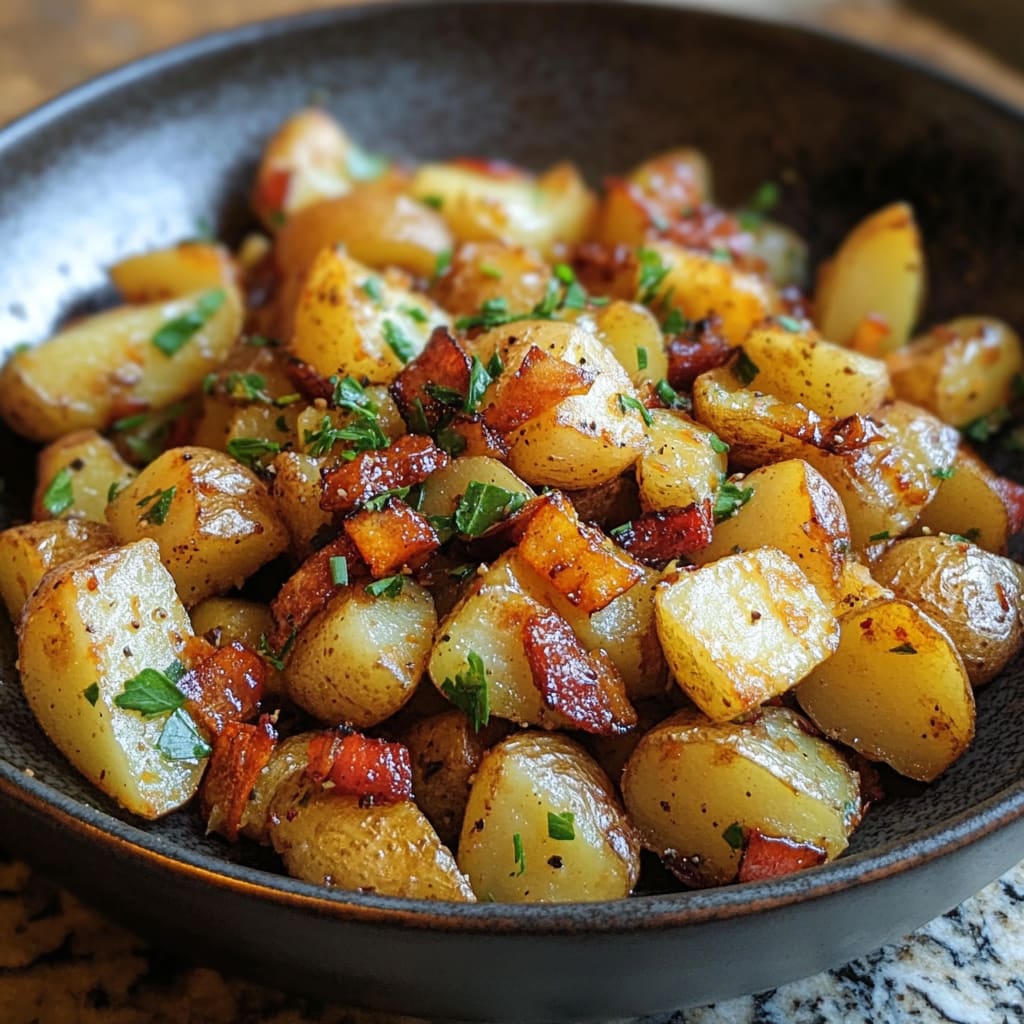The aroma of sizzling garlic in olive oil is enough to make anyone’s mouth water. Spaghetti Aglio e Olio is Italian simplicity at its most brilliant—a classic pasta dish that transforms just a handful of humble ingredients into something truly magical. This traditional recipe from Naples celebrates the perfect marriage of golden garlic, quality olive oil, and a hint of heat from red pepper flakes, all coating strands of perfectly al dente spaghetti. You’ll learn how to create this deceptively simple yet deeply satisfying pasta that Italian grandmothers have perfected for generations.
Why You’ll Love This Recipe
There’s something incredibly comforting about the elegant simplicity of Spaghetti Aglio e Olio. This dish proves that exceptional cooking doesn’t always require complicated techniques or expensive ingredients—sometimes the most basic components create the most profound flavors.
The magic lies in the textural contrasts: tender strands of pasta against the slight crunch of toasted (but never burnt) garlic. The warm, peppery olive oil creates a light sauce that clings perfectly to each strand of spaghetti without weighing it down like cream-based alternatives.
Best of all, this garlic pasta recipe comes together in just 15 minutes, making it perfect for busy weeknights when you crave something delicious but don’t have hours to spend in the kitchen. It’s also incredibly adaptable—a blank canvas that welcomes additional ingredients while still honoring its humble roots.
Ingredients
For the perfect Spaghetti Aglio e Olio, quality matters when you’re working with so few ingredients:
• 1 pound (450g) spaghetti
• 6-8 cloves garlic, thinly sliced (not minced)
• 1/2 cup (120ml) extra virgin olive oil
• 1-2 teaspoons red pepper flakes (adjust to your heat preference)
• 1/2 cup (15g) fresh Italian parsley, chopped
• 1/2 cup (50g) freshly grated Parmesan cheese (optional but recommended)
• Salt, to taste
• Freshly ground black pepper, to taste
The olive oil should be high-quality extra virgin—it’s the backbone of this simple garlic olive oil pasta. When possible, seek out Italian-imported oil with a fruity, peppery finish. For garlic, look for firm, fresh bulbs with tight skin, as they’ll provide the cleanest flavor without bitterness.
Pro Tips
Creating perfect Spaghetti Aglio e Olio requires attention to three critical techniques:
First, the garlic must be sliced—not minced or crushed. Thin slices allow the garlic to toast slowly and evenly, developing a nutty flavor without burning. If you mince the garlic, it will cook too quickly and potentially become bitter. Aim for slices thin enough to become tender but thick enough (about 1mm) to maintain some texture.
Second, control your heat carefully when cooking the garlic. Start with a cold pan and cold oil, then bring up to medium-low heat gradually. This slow approach allows the garlic to infuse the oil properly while gently turning golden rather than brown. The moment you see the edges beginning to turn golden, it’s time to add your pasta water and pasta.
Finally, reserve at least 1 cup of starchy pasta water before draining. This liquid gold is essential for creating the light sauce that will coat your pasta. The starch helps the olive oil adhere to the noodles, creating a silky emulsion that defines authentic Italian pasta.
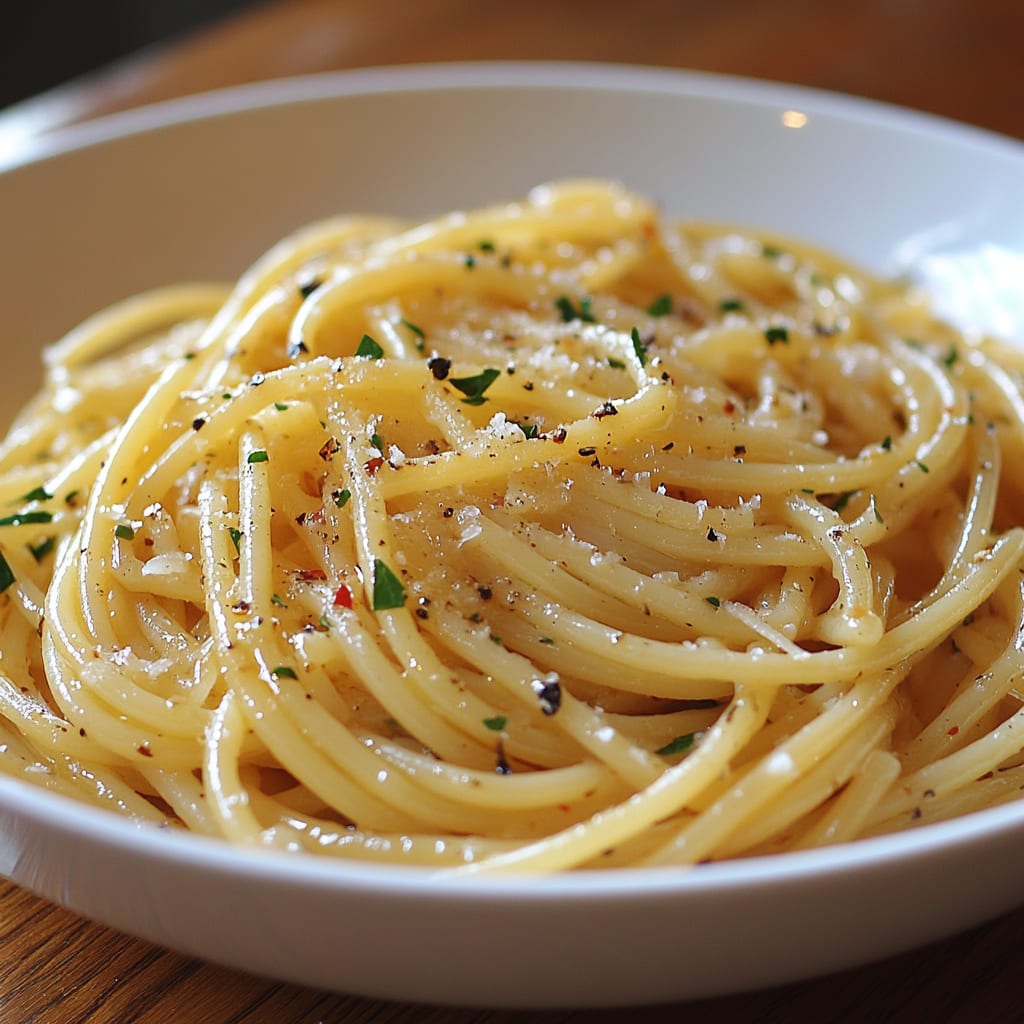
Instructions
Step 1: Cook the Pasta
Bring a large pot of water to a rolling boil. Add 1-2 tablespoons of salt—the water should taste like the sea. Add spaghetti and cook until al dente according to package directions, usually 9-11 minutes. Before draining, reserve 1 cup of the starchy pasta water. Drain the pasta but don’t rinse it—that starch is essential for the sauce.
Step 2: Prepare the Garlic Oil
While the pasta cooks, start your sauce. Place a large, cold skillet on the stove and add the olive oil. Add the sliced garlic and set over medium-low heat. Allow the garlic to slowly become fragrant and gradually turn golden, stirring occasionally. This gentle approach infuses the oil with garlic flavor without burning. This should take about 3-4 minutes—be patient and watchful.
Step 3: Build the Sauce
Just as the garlic begins to turn golden (not brown), add the red pepper flakes to the oil. Cook for 30 seconds to bloom their flavor. Add 1/4 cup of the reserved pasta water to stop the garlic from cooking further. The water will sizzle dramatically—this is normal! Let this mixture simmer for about a minute to slightly reduce.
Step 4: Combine and Finish
Add the drained pasta directly to the skillet with the garlic oil. Toss vigorously with tongs to coat every strand. If the pasta seems dry, add more reserved pasta water, a splash at a time, until you reach a silky consistency. The pasta should be glossy but not swimming in liquid. Cook together for 1-2 minutes to allow the pasta to absorb the flavors.
Step 5: Garnish and Serve
Remove from heat and add most of the chopped parsley, saving some for garnish. Add freshly ground black pepper and toss again. Taste and adjust salt as needed. Divide the Spaghetti Aglio e Olio among warm plates, sprinkle with the remaining parsley, and offer the grated Parmesan at the table for those who want it (traditionalists might skip the cheese entirely).
Variations
While purists may insist on the simplicity of classic Spaghetti Aglio e Olio, several delicious variations have evolved:
Spaghetti Aglio, Olio e Peperoncino: Simply increase the red pepper flakes to 1 tablespoon for a properly fiery version popular throughout southern Italy. This spicier garlic pasta with chili is perfect for those who enjoy heat.
With Seafood: Transform this dish by adding 1/2 pound of quick-cooking seafood like shrimp or calamari. Sauté them separately with a little garlic and olive oil until just cooked, then toss with the finished pasta. The sweet seafood beautifully complements the garlic and olive oil base.
Lemon Variation: For a brighter profile, add the zest and juice of one lemon along with the parsley at the end of cooking. The citrus cuts through the richness of the olive oil and adds a refreshing dimension to this classic Italian garlic pasta.
Storage and Serving
Spaghetti Aglio e Olio is at its absolute best when served immediately after cooking. However, leftovers can be stored in an airtight container in the refrigerator for up to 2 days. To reheat, add a small splash of water and warm gently in a skillet over medium-low heat, tossing frequently to revitalize the sauce.
For serving, consider these complementary pairings:
A simple arugula salad dressed with lemon juice and olive oil provides a peppery contrast to the rich pasta.
Crusty Italian bread is essential for sopping up the last bits of garlic-infused oil left on your plate—it’s too delicious to waste.
For wine pairing, choose a crisp, acidic white like Pinot Grigio or Vermentino that will cut through the oil and complement the garlic without overwhelming the dish’s simplicity.
FAQs
Why is my garlic turning brown too quickly?
Your heat is likely too high. Start with cold oil in a cold pan and heat gradually. You want the garlic to slowly turn golden, not quickly brown. If it’s cooking too fast, remove the pan from heat temporarily.
Is it authentic to add Parmesan cheese?
Traditionally, Spaghetti Aglio e Olio doesn’t include cheese. However, many modern interpretations do add Parmesan. Choose based on your preference—both versions are delicious.
Can I use a different type of pasta?
While spaghetti is traditional, other long pasta like linguine or fettuccine works well. The key is having enough surface area for the oil to coat properly.
My sauce seems dry—what happened?
Always save pasta water! This starchy liquid is crucial for creating a silky emulsion with the olive oil. If your pasta seems dry, add more pasta water a tablespoon at a time while tossing.
Can I make this ahead for a dinner party?
This dish is best made just before serving. Instead of making ahead, have all ingredients prepped and ready so you can quickly prepare it when guests arrive.
Conclusion
This Spaghetti Aglio e Olio is comfort food at its finest—a testament to how the humblest ingredients can create the most profound flavors when treated with care and respect. It’s the kind of dish that reminds us why Italian cuisine has conquered the world: not through complexity, but through an unwavering commitment to quality ingredients and perfect technique. Whether you’re cooking a quick weeknight dinner or impressing friends with your culinary knowledge, this garlic and olive oil pasta demonstrates that true sophistication often lies in simplicity.
Print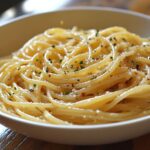
Spaghetti Aglio e Olio
- Prep Time: 5 minutes
- Cook Time: 10 minutes
- Total Time: 15 minutes
- Yield: 4 servings 1x
- Category: Dinner
- Method: Sauteing
- Cuisine: Americaine
Description
Spaghetti Aglio e Olio – A quick, comforting dish with garlic, olive oil, and chili flakes. Easy recipe for a crowd-pleasing meal.
Ingredients
- 1 pound (450g) spaghetti
- 6–8 cloves garlic, thinly sliced (not minced)
- 1/2 cup (120ml) extra virgin olive oil
- 1–2 teaspoons red pepper flakes (adjust to your heat preference)
- 1/2 cup (15g) fresh Italian parsley, chopped
- 1/2 cup (50g) freshly grated Parmesan cheese (optional but recommended)
- Salt, to taste
- Freshly ground black pepper, to taste
Instructions
- Step 1: Cook the Pasta Bring a large pot of water to a rolling boil. Add 1-2 tablespoons of salt—the water should taste like the sea. Add spaghetti and cook until al dente according to package directions, usually 9-11 minutes. Before draining, reserve 1 cup of the starchy pasta water. Drain the pasta but don’t rinse it—that starch is essential for the sauce.
- Step 2: Prepare the Garlic Oil While the pasta cooks, start your sauce. Place a large, cold skillet on the stove and add the olive oil. Add the sliced garlic and set over medium-low heat. Allow the garlic to slowly become fragrant and gradually turn golden, stirring occasionally. This gentle approach infuses the oil with garlic flavor without burning. This should take about 3-4 minutes—be patient and watchful.
- Step 3: Build the Sauce Just as the garlic begins to turn golden (not brown), add the red pepper flakes to the oil. Cook for 30 seconds to bloom their flavor. Add 1/4 cup of the reserved pasta water to stop the garlic from cooking further. The water will sizzle dramatically—this is normal! Let this mixture simmer for about a minute to slightly reduce.
- Step 4: Combine and Finish Add the drained pasta directly to the skillet with the garlic oil. Toss vigorously with tongs to coat every strand. If the pasta seems dry, add more reserved pasta water, a splash at a time, until you reach a silky consistency. The pasta should be glossy but not swimming in liquid. Cook together for 1-2 minutes to allow the pasta to absorb the flavors.
- Step 5: Garnish and Serve Remove from heat and add most of the chopped parsley, saving some for garnish. Add freshly ground black pepper and toss again. Taste and adjust salt as needed. Divide the Spaghetti Aglio e Olio among warm plates, sprinkle with the remaining parsley, and offer the grated Parmesan at the table for those who want it (traditionalists might skip the cheese entirely).
Notes
Fresh ingredients will always yield the best flavor results.
Nutrition
- Serving Size: 1 plate (approximately 200g)
- Calories: 450 calories per serving
- Sugar: 2 grams
- Sodium: 400 mg
- Fat: 24 grams
- Saturated Fat: 4 grams
- Unsaturated Fat: 18 grams
- Trans Fat: 0 grams
- Carbohydrates: 50 grams
- Fiber: 3 grams
- Protein: 10 grams
- Cholesterol: 5 mg

